The Earth Moon System
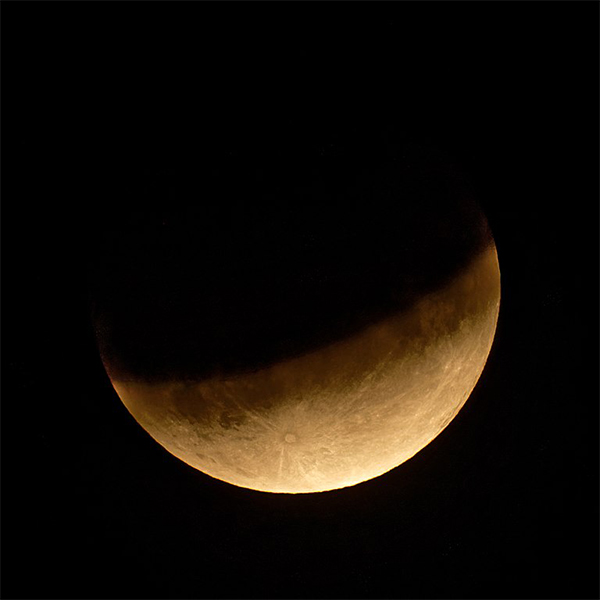
Lunar eclipse (Marie-Lan Taÿ Pamart, Wikimedia Commons)

Lunar eclipse (Marie-Lan Taÿ Pamart, Wikimedia Commons)
How does this align with my curriculum?
Answers to some common questions about Earth’s Moon.
Have you ever looked at the Moon at night and wondered why it looks the way it does? You are not alone! People all over the world have wondered the same thing for thousands of years. Here are some answers to questions about the Moon.
Why does the Moon look white?
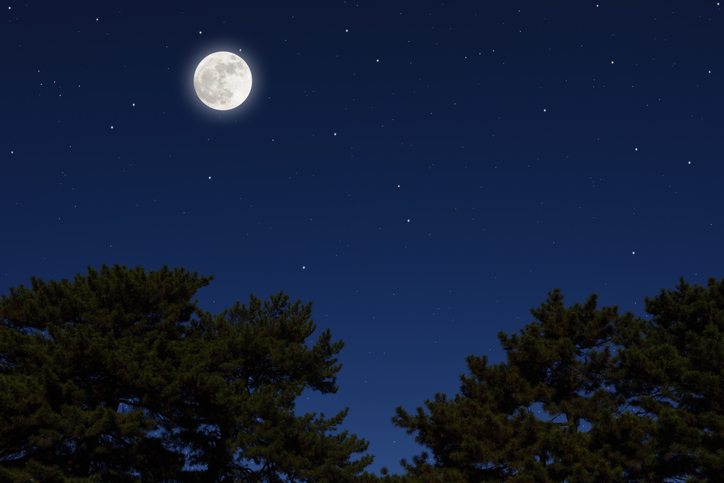
Bright Moon (Source: kyoshino via iStockphoto).
Image - Text Version
Shown is a colour photograph of dark blue night sky with stars and a full, bright, grey and white moon.
In the top left, the moon is round and bright, pale grey with visible, darker craters. The sky around is dark blue and scattered with tiny white stars. The sky gets slightly brighter closer to the ground. Leafy, dark green trees frame the bottom edge of the image.
Why do we always see the same side of the Moon?
Just like the Earth revolves around the Sun, the Moon revolves around the Earth. The Moon revolves around Earth once every 27.3 days. We call this length of time a lunar month. The time it takes for the Moon to rotate once on its axis is about 27 Earth days. This is a lunar day. For comparison, the Earth completes one rotation every 24 hours and the Moon completes one rotation every 709 hours.

Revolution of the Moon with and without rotation (Source: Stigmatella aurantiaca [public domain] via Wikimedia Commons).
Image - Text Version
Shown is a black and white animated gif of two moons moving around two large, white circles.
The gifs are almost identical. The Moon is detailed, with textures and craters, while a plain circle illustrates Earth. The Moon moves around Earth at the same speed and distance in each one. In the left animation, the Moon is slowly rotating as it revolves. On the right, it stays static as it moves.
What is a Supermoon?
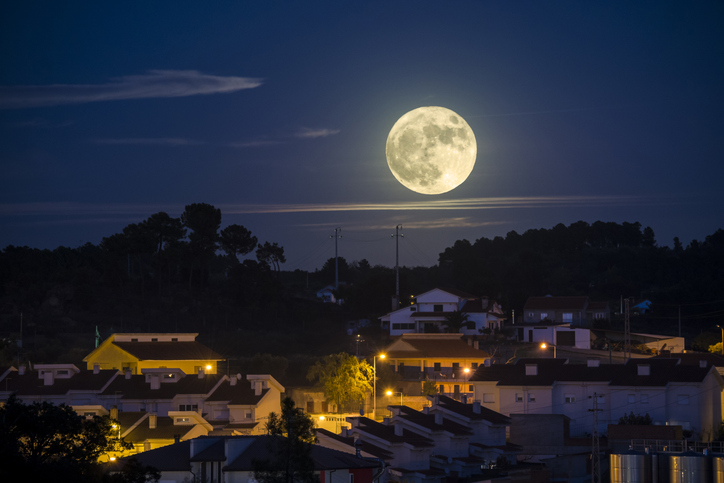
Full Moon rising over a town (Source: Ruibento via iStockphoto).
Image - Text Version
Shown is a colour photograph of the Moon appearing large and pale yellow.
The Moon sits just above dark trees on the horizon. It is pale yellow, illuminating the dark sky and thin clouds around it. In the foreground, streets and houses are lit by streetlights.
Another reason has to do with the shape of the Moon’s orbit. The Moon’s orbit is not a perfect circle. It is more of an oval shape. This means that there are times when the Moon is closer to the Earth. When we see a full Moon that is in the position, we call it a supermoon.
Why does the Moon look different each day?
The Moon does not always look like a white circle. Sometimes it looks like a half of a circle. Sometimes it looks like a crescent shape. Sometimes you cannot see it at all! Why is this?
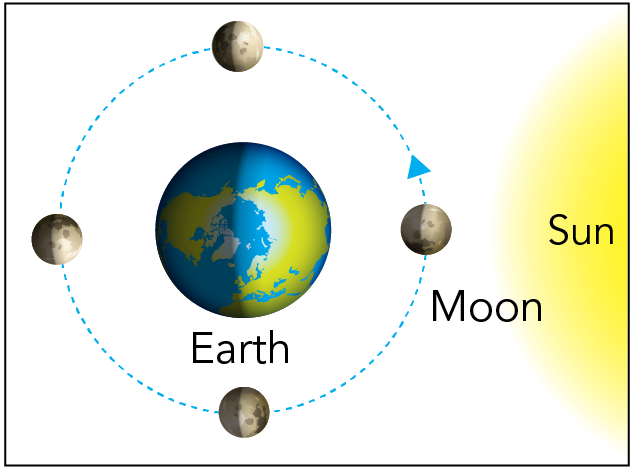
Orientation of the Earth, the Moon and the Sun (Let’s Talk Science using an image by jack0m via iStockphoto).
Image - Text Version
Shown is a colour diagram illustrating the Moon moving around the Earth, next to the sun.
The Earth is labelled, in the centre left of the illustration. The left half is in shadow, and the right is illuminated. A large yellow half-circle stretches along the right edge of the image. This is labelled "Sun." The Moon is shown four times along a blue, dotted circular path around the Earth. An arrow indicates the Moon is moving counter-clockwise. At every point along the path, the right half of the Moon is illuminated, and the left half is in shadow. The craters illuminated on the Moon are different at each point, indicating its rotation.
Misconception Alert
The shadow on the Moon is not caused by the Earth except in the case of a lunar eclipse.
We call the pattern of light and shadow on the Moon as it revolves around the Earth the phases of the Moon.
Moon phases demonstration (2015) by the National Science Teaching Association (4:15 min.).
The moon has eight phases in each lunar cycle. Four we call primary phases and four we call secondary phases. Primary phases occur at a specific time each month. Secondary phases do not. They indicate that the Moon is in transition from one primary phase to the next.
| Four primary phases | Four secondary phases |
|---|---|
| 1. New Moon | 2. Waxing crescent |
| 3. First Quarter | 4. Waxing gibbous |
| 5. Full Moon | 6. Waning gibbous |
| 7. Third Quarter | 8. Waning crescent |
Try this!
How can you tell if the Moon is waxing or waning? When the Moon is waxing, it looks like the front of a capital letter “D”. When the Moon is waning, it looks like the capital letter “C”. Look at the Moon and try to figure out which phase it is in!
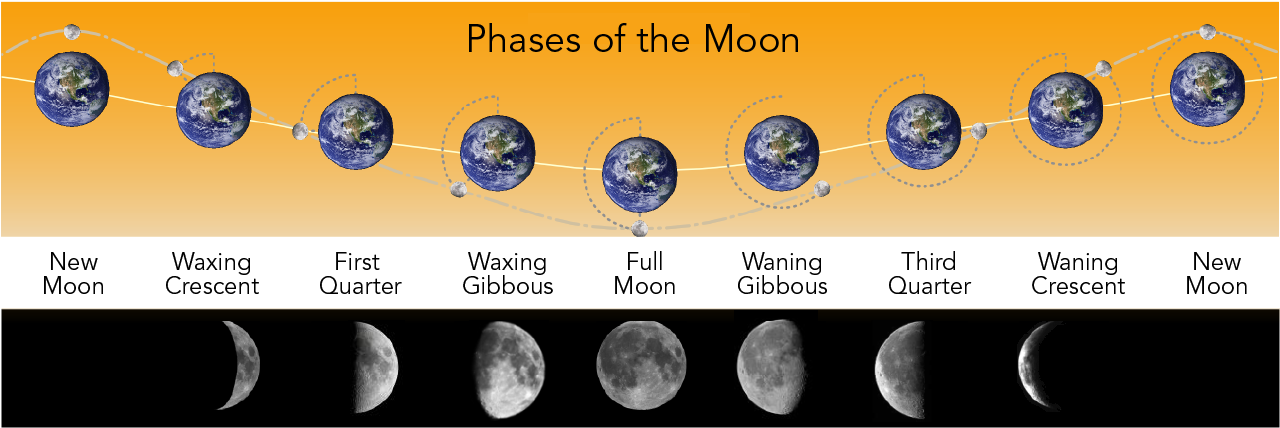
The phases of the Moon in order of their appearance (Source: Fresheneesz~commonswiki [public domain] via Wikimedia Commons).
Image - Text Version
Shown is a colour illustration of how the Moon revolves around the Earth, and how each phase appears in the night sky.
The image is wide - a panoramic format. The title "Phases of the Moon" is in large black text across the top centre of the image.
The top half of the image has a gold background. It shows nine images of the Earth, connected by a thin white line, laid out in a shallow V shape. There is a tiny grey moon next to each globe, in a different position each time.
Starting on the top left, the Moon is directly above the top of the globe. The Moon's position moves counterclockwise in each illustration, drawing a dotted blue line around the planets that gets longer in each illustration. By the top right illustration, the Moon has circled one whole rotation around the Earth, and is back to the top again.
The bottom part of the illustration is divided in two. The top half has a white background, where the phases of the Moon are labelled. The lower half has a black background, with nine illustrations of the Moon as seen from Earth, corresponding to the nine globes above.
Starting on the left, the Moon is not visible in the first illustration at all. The area appears plain black, in total shadow. This is labelled "New Moon." In the second, the right quarter of the Moon is visible, grey and cratered. This is labelled "Waxing Crescent." In the third, the whole right half of the Moon is visible. This is labelled "First Quarter." In the fourth, about three quarters of the right part of the Moon is visible, in a wide almond shape. This is labelled "Waxing Gibbous." In the fifth illustration, in the centre, the Moon is round and fully visible. This is labelled "Full Moon."
In the sixth illustration, about three quarters of the left side of the Moon is visible. This is labelled "Waning Gibbous." In the seventh illustration, the left half of the Moon is visible. This is labelled "Third Quarter." In the eighth illustration, the left quarter of the Moon is visible. This is labelled "Waning Crescent." In the final illustration, the moon is not visible at all. It appears plain black. This is labelled "New Moon."
What is a lunar eclipse?
Understanding Lunar Eclipses (2015) by NASA (1:58 min.).
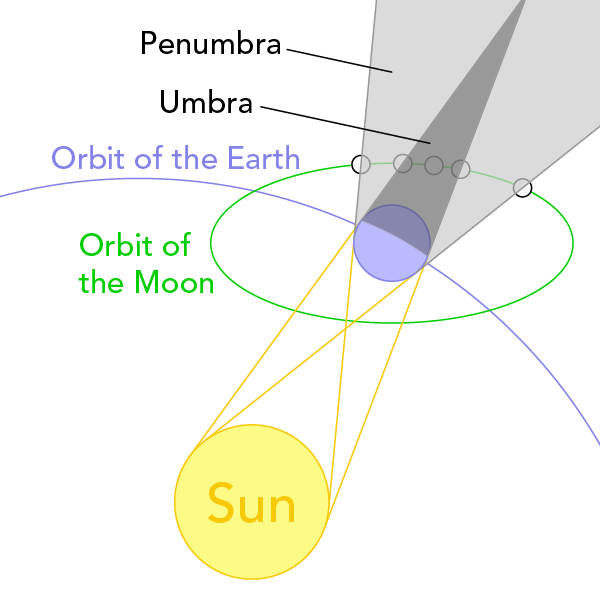
Areas of shadow during an eclipse (Source: Sagredo [public domain] via Wikimedia Commons).
Image - Text Version
Shown is a colour diagram showing the Earth's orbit, the Moon's orbit, and the rays of the Sun during lunar eclipses.
The largest shape in the diagram is a yellow circle on the lower left, labelled "Sun." The second largest shape is a purple circle. This sits along a curved purple line labelled "Orbit of the Earth'' in purple letters. Around this circle is a green line in a horizontal oval shape. Five small black circles appear along the top right part of the line. This is labelled "Orbit of the Moon '' in green letters.
Two pairs of straight yellow lines extend from the edges of the Sun, pointing at different angles toward the top right. The first pair of lines narrow until they meet the edges of the Earth. The second pair cross over about two thirds of the way to the Earth, then meet the edges of the Earth. The half of the Earth closest to the Sun is light purple. The half of the Earth farthest from the Sun is dark purple.
On the dark side of the Earth, two pairs of grey lines extend from its edges, toward the top right. The outside pair fan out to meet the top edge, and right edge of the illustration. The area in between the lines is shaded light grey. This is labelled "Penumbra."
The inside pair of lines are angled together to form a narrow triangle with the point at the top edge of the illustration. The area between these lines is shaded dark grey and labelled "Umbra."
Along the green line labelled "Orbit of the Moon," the first circle on the left circle intersects with the left edge of the penumbra. It is half white and half light grey. The second circle intersects with the left edge of the umbra. This is half light grey and half dark grey. The third circle is in the centre of the umbra. This is completely dark grey. The fourth circle intersects with the right edge of the umbra. This is half dark grey and half light grey. The fifth circle intersects with the right edge of the penumbra. This is half light grey and half white.
- A total lunar eclipse occurs when the Earth is exactly in between the Moon and the Sun. The Moon is completely in the deep shadow of the umbra.
- A partial lunar eclipse occurs when only part of Earth's shadow covers the Moon. Part of the Moon is in the shadow of the umbra and the rest is in the shadow of the penumbra.
- A penumbral lunar eclipse occurs when the Moon is only covered by the shadow of the penumbra. This shadow is pretty faint. Most people will not even notice it.
Why does the Moon look red during an eclipse?
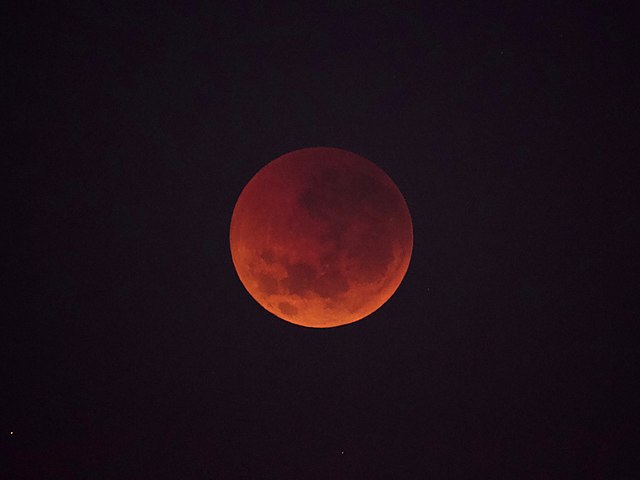
Blood Moon (Source: Mark Gillow [public domain] via Wikimedia Commons).
Image - Text Version
Shown is a colour photograph of the full Moon, illuminated in dark orange light.
The background is black. The Moon is round and full in the centre. It is not bright, but dark orange, with darker orange craters.

Paths of light and shadows that cause the Moon to look reddish during a total lunar eclipse (Let’s Talk Science using an image by pialhovik via iStockphoto).
Image - Text Version
Shown is a colour illustration of how the Sun's rays hit the Earth's atmosphere and the Moon during a total lunar eclipse.
A large orange, yellow and white speckled circle on the left side of the illustration is labelled "Sun." To the right is a small colour illustration of the globe, labelled "Earth." This is surrounded by a thick teal stripe labelled "Atmosphere." The left half of Earth is bright, while the right half is grey with shadow. Near the right edge of the illustration is a small orange circle labelled "Moon." The left half of the circle is bright orange. The right half is dark orange.
Two pairs of thin, straight black lines extend from the top and bottom edges of the Sun toward the right of the illustration. The outside pair angle together so they extend to touch the edges of Earth's atmosphere, then the edges of the Moon. The area between these lines, to the right of the Earth, is shaded light grey and labelled "Penumbra."
The inside pair of lines angle more sharply together. They cross over about two thirds of the way from the Sun, then cut through the stripe of the Earth's atmosphere, then fan out to the top right and bottom left corner of the image. The area between these lines, to the right of the Earth, is shaded orange and labelled "Umbra."
Why don’t we get an eclipse every month?
Even though the Earth passes in front of the Moon every month, we don’t see an eclipse. Why is this? The reason has to do with the Moon’s orbit. The orbit of the Moon is tilted in relation to the orbit of the Earth.
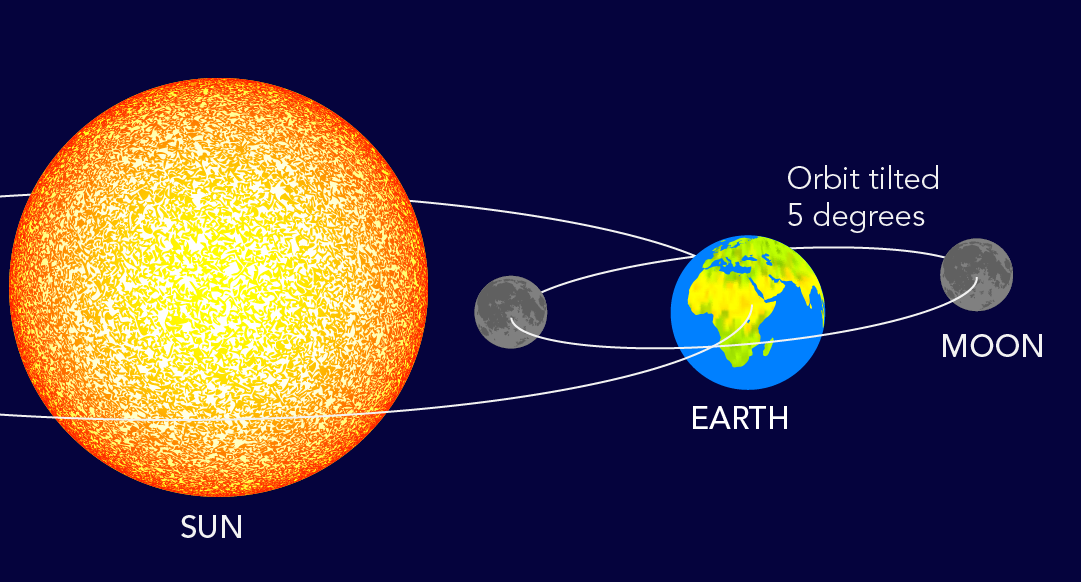
The orbit of the Moon is tilted relative to that of the orbit of Earth (Let’s Talk Science using an image by pialhovik via iStockphoto).
Image - Text Version
Shown is a colour illustration of how the Earth's orbit and the Moon's orbit intersect.
The background is dark blue. A large orange, yellow and white speckled circle on the left is labelled "Sun." A thin, white line in a long, stretches around the Sun in horizontal oval shape. Along this line, to the right, is a smaller blue and green circle labelled "Earth."
Another thin white line in a smaller oval, surrounds the Earth, with small grey illustrations of the Moon along it on the left and right. This is tilted slightly down to the left, and overlaps with the line indicating the Earth's rotation around the Sun. This is labelled "Orbit tilted 5 degrees."
Most of the time, the Moon travels above or below Earth’s imaginary 2D plane or the ecliptic. The ecliptic is the plane of the Earth’s orbit around the Sun. Only when the two orbits align can we get an eclipse.
Did you know?
The Moon is moving away from the Earth. Someday it will no longer be close enough to fall completely within the Earth’s umbral shadow. When that time comes, total lunar eclipses will be a thing of the past.
The next time you look up at the night sky, what questions about the Moon will YOU want to ask?
Learn More
Your guide to lunar eclipses
This article from the Canadian Space Agency (CSA) explains how a lunar eclipse occurs, how you can observe one and when the next lunar eclipse will be visible in Canada.
2015 Year in Review - 8 highlights in space, science and the CSA
This article from the CSA describes a rare event - a super blood moon total lunar eclipse.
Supermoon, Blood Moon, Blue Moon and Harvest Moon
This article from NASA SpacePlace explains the different kinds of full moons.
How the Moon orbits Earth (2020)
This YouTube video from Interplanetary uses real data for the month of April 2020 to show the exact rotations, tilts, inclination, orbital velocity, sunlight angles & views of our Earth-Moon system.
References
Boeck, M. (2022, Dec. 13) Earth’s Moon - lunar phases and eclipses. NASA.
Boeck, M. (2022, Dec. 13) Earth’s Moon - In-depth. NASA.
Byrd, D. (2020, June 29) What’s a penumbral eclipse of the Moon? Earthsky.
Canadian Space Agency (CSA) (2022, April 19) The Moon our neighbour in space.
Canadian Space Agency (CSA) (2022, April 19) Next eclipses visible from Canada.
Erickson, K. (2022, Dec. 7) Supermoon, blood moon, blue moon and harvest moon. NASA Science SpacePlace.
Freudenreich, C. (2022, Sept. 7) Moon Phases. How Stuff Works.
National Geographic (2018, Jan, 30) Lunar Eclipse 101 [Video]. YouTube.
Tillman, N.T. (2021, June 17). Does the Moon Rotate? Space.com